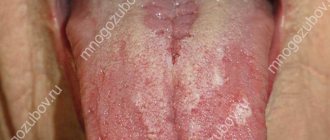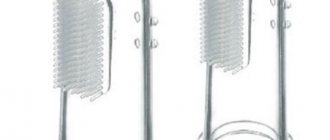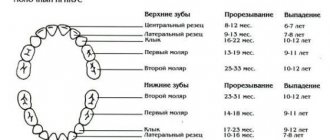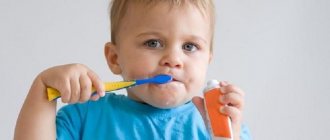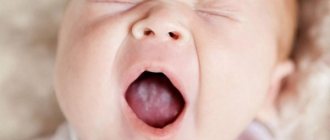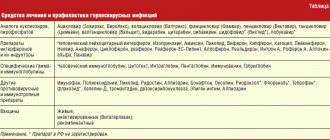Teething is an important event in the life of every child, because he will finally be able to taste solid food. However, the appearance of baby teeth is not always associated with joy and the arrival of the Tooth Fairy. Many children can become irritable and apathetic during the teething period. For some, vomiting, diarrhea, or fever occur when teeth appear.
Whether vomiting is actually caused by teething is controversial. There are no studies confirming the relationship between these natural processes. Most experts agree that teething may cause local pain, but not discomfort in other parts of the body such as rashes or diarrhea.
Other teething symptoms
Some children experience teething without any pain or discomfort. Others may exhibit specific symptoms:
- increased desire to chew;
- salivation;
- cry;
- irritability;
- inability to sleep;
- loss of appetite
- red, tender and swollen gums.
Parents’ concern for the baby’s condition is understandable, because they want to know exactly why the baby’s mood suddenly deteriorated or he began to be capricious.
According to the American Academy of Pediatrics, none of the following symptoms predict the onset of teething:
- cough;
- disturbed sleep;
- decreased appetite;
- vomit;
- diarrhea;
- rash;
- heat.
Vomiting or regurgitation?
In infants, vomiting should be distinguished from regurgitation. With regurgitation, as with vomiting, the contents of the stomach return to the mouth. However, this happens once, immediately after eating. The reason is overfeeding or swallowed air. The air exits back through the esophagus; a slight tension of the abdominal muscles is enough for this. This fundamentally distinguishes regurgitation from vomiting spasms, in which both the abdominal muscles and the diaphragm are involved. When vomiting, the child behaves restlessly, turns red from overexertion, and after an attack he feels weakened.
Why does a baby vomit when teething?
Teething is often wrongly blamed for many symptoms. However, research shows that cough, congestion, vomiting, diarrhea, rashes, fever (over 38°C) and sleep-wake problems are not symptoms of teething. In addition, scientists have found that no single set of symptoms can accurately signal the onset of teething.
The American Academy of Pediatrics explains that from the age of 6 months, a child's immune system weakens, losing maternal antibodies, which increases the risk of exposure to a wide range of diseases, including viruses and bacteria. This is why vomiting may have another cause, but not teething.
Causes of vomiting in a child
The cause of vomiting in children can be:
- teething;
- reaction to the introduction of complementary foods;
- indigestion or overfeeding;
- mental reaction (in children over 3 years old);
- the body's reaction to changes in climate zone;
- gastroesophageal reflux (involuntary reflux of gastric contents into the esophagus);
- acute infections;
- diseases of the pancreas, gall bladder and liver;
- congenital gastrointestinal defects;
- diseases of the central nervous system;
- ingestion of a foreign body.
How to relieve teething discomfort?
To relieve gum discomfort, you can try massaging or rubbing them with your fingers, or giving your baby a chilled teething ring. If your baby is already chewing, you can offer him raw fruits and vegetables.
Do not give your child painkillers or gum rubs, such as viscous lidocaine or benzocaine. These medications may be harmful if swallowed. The US Food and Drug Administration opposes the use of these drugs due to the risk of overdose.
Overdose symptoms include:
- nervousness;
- confusion;
- vomiting;
- convulsions.
Causes and mechanism of regurgitation
The following reasons are identified:
- Filling the stomach with air, which the child can swallow while eating. This is the most common reason, which requires practically no special correction.
- Muscular weakness of the valve between the esophagus and stomach. It develops as the child grows and begins to function normally by the first year of life. Therefore, food can pass from the stomach into the esophagus without hindrance, which is what happens during regurgitation.
- Food allergies (or food intolerances). Most often it manifests itself as skin reactions, but in rare cases, regurgitation may be a symptom.
- Congenital defects of the gastrointestinal tract. The digestive system is quite complex; some disturbances in its structure can lead to digestive problems that begin to appear immediately after birth. Thus, narrowing in the area of the gastrointestinal junction can lead to frequent atypical regurgitation.
Next, we will provide recommendations on how to distinguish pathology from the norm, and when you need to see a doctor. If regurgitation is caused by a disease, then it is reasonable to begin treatment as soon as possible.
When to see a doctor
Teething can usually be managed at home. However, if a child has a high fever and symptoms not related to teeth, this is a reason to consult a doctor.
Some symptoms, such as vomiting, should not be attributed to teething because they may have a more serious underlying cause. Your doctor may want to run some tests to rule out other health problems.
On the Vikids platform you can:
Timing of teeth appearance. When do teeth start cutting?
Sometimes parents expect that teeth will start cutting in on time, and if this does not happen, they begin to get seriously nervous, because late appearance of teeth can be one of the symptoms of rickets. And the therapist at the appointment can tell you the timing of their appearance for the same reason.
Don’t panic if your child is already 8-9 months old and still has no teeth. In fact, this is only one of many symptoms of such a serious disease that cannot be considered on its own. The process of teething is individual for each child.
The first tooth can appear between 3 and 10 months. And both extreme options are the norm. Only the later appearance of the first tooth can cause some concern in the absence of other external abnormalities.
The average time for teeth to appear can be represented as follows:
- The 2 lower incisors appear first at 6-8 months of age;
- all 4 upper incisors grow sequentially in the period from 8 to 12 months;
- at approximately 10-13 months, the lower lateral incisors appear;
- the first molars, first the upper and then the lower, are cut at 12-15 months;
- fangs appear at 18-20 months, also first the upper ones, then the lower ones.
All 20 teeth finally appear by 2.5-3 years. Moreover, if the baby’s teeth began to cut early, then the process may be completed earlier - already by 2 years. If, on the contrary, the first tooth appeared only at 9-10 months, the last ones can appear only at 3-5 years.
After a year, the baby may cut several teeth at the same time, and then this process can be really very painful.
How to help a baby
If vomiting is accompanied by other symptoms characteristic of the appearance of baby teeth, there is no cause for concern. It is recommended to consult your pediatrician regarding this issue.
It is difficult to prevent the development of gag reflexes , but parents are able to make their baby feel better by:
- massage the gums in the places where the molars erupt. Massage the gums with bare fingers. Any pressure should be avoided;
- the use of special teethers, which can be found in a baby goods store. These devices eliminate itching and discomfort in the gum area;
- treating gums with gels that have an anesthetic effect (Dentol - available at the pharmacy without a prescription);
- timely elimination of saliva, which is abundantly released during the teething of the incisors.
Parents should not insist on their baby eating large amounts of food, which can cause vomiting.
Give food in small portions, after thoroughly grinding it.
Where does the rubella rash appear first in children? How to distinguish it from prickly heat? Let's ask the doctor!
What are the symptoms and treatment of scarlet fever in children? Our article will talk about this.
You can learn about the treatment of bacterial stomatitis in children from this publication.
Danger signs
Responsible parents should be aware of dangerous symptoms that require consultation with a doctor:
- The baby is very restless and often turns around and arches his back when burping or feeding. This symptom may indicate chronic irritation of the esophagus.
- Regurgitation is frequent, abundant, observed after each feeding.
- The child is showing signs of dehydration.
- Regurgitation that first appeared after the first half of the year.
- Prolonged regurgitation without improvement (the same frequency and the same volume of regurgitation in a child 1 year and older).
- Regurgitation is accompanied by an increase in temperature.
- The child does not gain weight or even loses it.
- You cannot independently determine whether your baby is spitting up or vomiting.
There are even more dangerous symptoms, when they appear, you need to call an ambulance:
- The child stopped breathing after burping.
- A bluish tint appears on the lips and face.
- After regurgitation, the child lost consciousness.
- Reflux (stomach contents) that is green or brown can be a sign of intestinal obstruction or stomach bleeding.
Aspiration is extremely dangerous in infants who are unable to clear food from their airways on their own. The only thing parents can do is call an ambulance. It is not recommended to try to help your child on your own.
Aerophagia - causes and solutions to the problem
To prevent aerophagia, you need to monitor feeding techniques.
Swallowing air is common during feeding. The reasons for excess air ingress are as follows:
- The baby is worried and sucks greedily. At the same time, he opens his mouth wide. The reason may be a lack of milk from the mother or its complete absence.
- Mistakes during feeding. This happens with both breastfeeding and artificial feeding.
- Muscle weakness in a toddler due to problems during childbirth.
Prevention of aerophagia:
Child behavior
The mechanism of regurgitation is such that components of gastric juice enter the esophagus along with the food eaten. As you know, it has high acidity and irritates the esophageal mucosa. As a result, the child experiences discomfort and can become quite restless. It’s very easy to check whether your baby’s anxiety is related to regurgitation - just lay him on his back. If the problem is regurgitation, then the baby will behave even more restlessly. If not, then the horizontal position will not bring him discomfort.
If regurgitation occurs frequently, it is called regurgitation syndrome. It can lead to complications - chronic irritation of the respiratory tract. As a result of the constant aggressive effect of gastric juice on the mucous membranes of the upper respiratory tract, the latter are susceptible to an inflammatory process. Therefore, it is important to monitor the child’s condition and, if necessary, consult a doctor.
